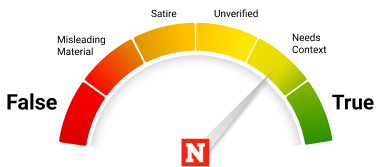With the fallout from the COVID-19 pandemic still being felt, the lockdown-weary public shudders at media coverage of new worrying viruses entering the frame.
The ongoing spike in monkeypox cases and the resurgence of polio across the developed world have brought some of those fears to the fore, and given fuel to existing anti-vaccine narratives on social media.
With so many confusing and misleading claims circulating online, Newsweek Fact Check looked into what polio is, how it spreads, and the historical significance of polio vaccines.

First, some important context. Polio is a rare, but extremely contagious virus that has been around since ancient times, although it was not officially discovered until 1908.
It usually spreads through personal contact. Once in the body, it lives in a person's intestines and throat. Many people may not even realize that the virus is in their system, but, in severe cases, it can cause paralysis for which there is no cure.
According to the Centers for Disease Control and Prevention (CDC), 1 in 4 infected people will experience cold-like symptoms including a sore throat, fever, tiredness, headache, and stomach pain.
There have been decades of global efforts to eradicate the wild virus completely. And thanks to widespread vaccination, it has indeed been eradicated in many places.
According to the CDC, five out of six World Health Organization (WHO) regions have been certified as free of wild polio: the African Region, the Americas, Europe, South East Asia and the Western Pacific.
However, in recent months, the virus has been detected in densely populated areas across the developed world, including Jerusalem, New York, and London.
This resurgence has been accompanied by reports and claims on social media suggesting that the polio vaccine is to blame, but the facts are, as always, a little more complicated.
Claim
Many believe that polio cases today are caused by an oral vaccine—one of the methods of eradicating the virus which is still used in several countries. It is mainly still used where the virus is still endemic, such as Afghanistan and Pakistan, due to its convenience.
Genetic analysis of the samples confirmed that the strain of polio responsible for the cases in New York, London and Jerusalem is vaccine-derived. Cases of vaccine derived polio have increased in recent years. In 2020, there were 1,081 cases of vaccine-derived polio recorded worldwide. This was triple the number of cases recorded in 2019. According to Reuters reports from August 16, there have been 177 cases so far in 2022. This has triggered authorities to launch renewed vaccination campaigns.
In July, New York recorded its first polio case in a decade. The infected person was unvaccinated, and suffered paralysis as a result of the virus. Since then, health officials found multiple wastewater samples were positive for the virus. Some of these samples were found to be linked to the first case. Some experts suspect hundreds of people could be infected. As not everyone experiences polio symptoms, the spread can be difficult to track.
This has caused some to believe that it is the vaccine at fault for spreading the virus. And experts are concerned that it may deter people from getting vaccinated.
Many social media users have said that the oral vaccine itself is responsible for the outbreak. A Reddit thread from two years ago said that an outbreak in Africa was "caused by mutation of strain in vaccine."
One Twitter user questioned why Anthony Fauci, the Chief Medical Advisor to the President of United States, is continuing to tell the public to get vaccination.
"Let me get this right Fraudci, the answer to vaccine derived polio is more vaccine derived polio," the Twitter user wrote.
Let me get this right Fraudci, the answer to vaccine derived polio is more vaccine derived polio... pic.twitter.com/VVWwRwWhrr
— 𝚁𝙰𝙶𝙴 𝙰𝙶𝙰𝙸𝙽𝚂𝚃 𝚃𝙷𝙴 𝚅𝙰𝙲𝙲𝙸𝙽𝙴 (@72powpow) August 21, 2022
The Facts
As the CDC states, there are three wild types of poliovirus (WPV)—type 1, type 2, and type 3. Type 2 wild poliovirus was declared eradicated in September 2015, with the last case in India in 1999. Type 3 wild poliovirus was declared eradicated in October 2019. It was last detected in November 2012. Only type 1 wild poliovirus remains.
Due to this variation in virus types, people need protection from each one, so there are two different vaccines used to protect against polio disease—oral polio vaccine and inactivated poliovirus vaccine.
As health authorities have confirmed, the recent reemergence of the virus in the West is caused by a strain of vaccine-derived polio. It is connected to the weakened live poliovirus contained in the oral vaccine, according to the CDC.
The oral vaccine is given in the form of drops administered to the mouth. The U.S. discontinued its use in 2000, and now uses a vaccine based on inactivated poliovirus, which is injected into the arm or leg. Because inactivated poliovirus cannot replicate, it cannot revert to its wild form.
The oral vaccine is also deemed safe and effective, and is cheaper to produce, which has made it integral in reducing the virus' circulation globally, especially in the developing world.
However, there is a small chance that the virus contained in the oral vaccine can spread to other, unvaccinated individuals. For example, if a child is given the oral vaccine, the live virus remains in their system for a few days, meaning it has the potential to spread to others. Crucially, it does not pose a danger to those who are vaccinated.
"There are two issues here. The first is the risk to the person (usually a child) being vaccinated," Paul Hunter, a consultant for the WHO and professor in medicine at Norwich Medical School, part of the University of East Anglia in the U.K., told Newsweek.
"After the first dose of the oral vaccine, the risk of paralytic polio is about two to three cases per million doses. After subsequent doses, the risk is much lower still.
"The second risk is that after oral vaccine the child can shed the virus for a while and that can infect others if this goes on to continue to circulate, then the virus can mutate back towards full virulence eventually, and start to cause paralytic poliomyelitis in infected people."
Hunter said that the injected vaccine does not cause paralysis and cannot cause the virus to spread to others. However, it is not as effective at reducing transmission, "which is why the oral vaccine is still used in a few countries, especially where they have wild polio."
"Most things in epidemics start off as random events and this [spike in cases] is probably no different," he said.
"A recently vaccinated child from one of the few countries where the oral vaccine is still in use came into the U.K. and into an area where vaccine coverage is particularly poor, so population immunity is low.
"Normally we get a couple of sewage positives a year in the U.K. so introduction happens regularly, but not the subsequent spread.
"Though if the virus continues to circulate it is almost inevitable we would eventually see cases of paralysis. There was a recent case in New York. But if it continues to circulate for months the virus could through mutation become fully virulent and be a significant threat for paralysis."
Indeed, this is why experts continue to push populations to get vaccinated against polio, if they have not done so already.
According to a 2017 Q&A from WHO, more than 10 billion doses of oral polio vaccine (OPV) have been administered to nearly three billion children worldwide: "As a result, more than 13 million cases of polio have been prevented, and the disease has been reduced by more than 99%. During that time, 24 circulating vaccine-derived poliovirus (cVDPV) outbreaks occurred in 21 countries, resulting in fewer than 760 VDPV cases."
As the organization says, the small risk of cVDPVs is outweighed by the tremendous public health benefits associated with OPV.
"The solution is the same for all polio outbreaks: immunize every child several times with the oral vaccine to stop polio transmission, regardless of the origin of the virus," it says.
Hunter said that for people who are "up to date with their vaccinations schedules" the risk of the virus is "tiny."
"Those not up to date, there is a real risk in areas where the virus is circulating and this risk could grow as the virus mutates and evolves," he said.
The Ruling

Needs Context.
FACT CHECK BY NEWSWEEK
It is true that polio cases popping up around the globe are a vaccine-derived strain. They occur due to "virus shedding" by those vaccinated (who themselves are typically not affected). This type of spread only remains a problem in under-vaccinated communities. If a majority of a population remains unvaccinated, and the virus is allowed to circulate, it could become more dangerous. In other words, widespread vaccination is instrumental in preventing its spread.
Uncommon Knowledge
Newsweek is committed to challenging conventional wisdom and finding connections in the search for common ground.
Newsweek is committed to challenging conventional wisdom and finding connections in the search for common ground.
About the writer
Robyn White is a Newsweek Nature Reporter based in London, UK. Her focus is reporting on wildlife, science and the ... Read more
To read how Newsweek uses AI as a newsroom tool, Click here.






